M
I
C
R
O
S
T
O
R
Y
O
F
A
R
T
........................................................

NOW COMPLETED:

........................................................
MICROSTORY OF ART
ONLINE JOURNAL FOR ART, CONNOISSEURSHIP
AND CULTURAL JOURNALISM
........................................................
INDEX | PINBOARD | MICROSTORIES |
FEATURES | SPECIAL EDITIONS |
HISTORY AND THEORY OF ATTRIBUTION |
ETHNOGRAPHY OF CONNOISSEURSHIP |
SEARCH

........................................................



 >MICROSTORIES
>MICROSTORIES
- Richard Serra
- Martin Scorsese
- Claude Simon
- Sunshine
- Werner Herzog
- The Creation
- Marcel Duchamp
- Nino Rota
- Wölfflin and Woolf
- Hansjörg Schneider
- Kraftort Arkadien
- Visual Biography
- Schlaraffenleben
- Die Geisteswissenschaften
- The Voyeur
- Buzzword Sustainability
- Paul Verlaine
- Tao Yuanming
- New Beginning
- Seneca
- Still Lifes
- Charles Baudelaire
- Frédéric Chopin
- The Art History of Sustainability
- Wang Wei
- Solarpunk
- Historians of Light
- Lepanto
- Renaturalization
- Plates
- Snow in Provence
- Learning to See
- Picasso Dictionaries
- Peach Blossom Spring
- Picasso Tourism
- Tipping Points
- Sviatoslav Richter
- Weather Reports
- Treasure Hunt
- Another Snowscape in Picasso
- Picasso in 2023
- Dragon Veins
- The Gloomy Day
- The Art of the Pentimento
- Reforestation
- The Status of Painting
- Emergency Supply
- Punctuality
- Watching Traffic
- Zhong Kui
- How Painting Survived the 1990s
- Confirmation Bias
- Sustainability and Luxury
- Garage Bands
- Picasso and Artificial Intelligence
- Eyes of Tomorrow
- Picasso in 2023 2
- Gluing Oneself to Something
- Suburbia
- Bamboo
- Sustainability and Carpe Diem 1
- Interviews with Bruegel
- Sustainability and Carpe Diem 2
- Coffee & Sugar
- Bamboo 2
- Picasso in 2023 3
- Sustainability and Carpe Diem 3
- Cherry Orchard
- Old Magazines
- Chance
- Nick Drake
- Harlequin
- The Smartphone & the Art Book
- Atlas Syndrome
- The Kitchen
- Atlas Syndrome 2
- Consideration
- Tori Amos
- School
- Orchard Auctioning Day
- The Hundred Years’ War
- Sócrates
- Chameleon
- Nefertiti Bust
- Picasso as a Computer
- Sunflowers
- Philemon & Baucis
- Ode to the Radio
- Childhood
- Wimmelbild
- Restitution
- Nick Drake 2
- Wishful Thinking
- Sundays
- The Independent Scholar
- September
- The Fisherman by Pirosmani
- Microadventure
- Sociology
- Salvator Mundi
- Chillon
- Appassionata
- Amber
- Homer
- Berlin
- Planet Walk
- Improvisation
- Seeing Picasso
- These Nice Kids
- Robber
- The One
- The Sea Turtle
- Zoo
- Through the Hush
- Wunderkammer
- I Do Not Seek, I Find
- Shopping Mall
- Food Hamper
- The Secretary
- This Gate
- Nor Rainy Day
- House on a Hill
- Beautiful Island
- Second-hand Bookstore
- Flat
- Slap in the Face
- Serra, Wenkenpark
- Apologies
- The Bells
- Nordmann Fir
- Picasso Wanting To Be Poor
- Picasso, Pirosmani
- A Brief History of Sculpture
- 24 Sunsets
- Rusty Phoenix
- Glove
- Wintry Stanza
- A Song
- Like A Beatle
- Catching An Orange
- Solar Bees
- Permaculture

 >FEATURES
>FEATURES
- Van Gogh On Connoisseurship
- Two Museum’s Men
- Ende Pintrix and the City in Flames
- Titian, Leonardo and the Blue Hour
- The Man with the Golden Helmet: a documentation
- Un Jury d’admission à l’expertise
- Learning to See in Hitler’s Munich
- Leonardo da Vinci and Switzerland
- The Blue Hour Continued
- The Blue Hour in Louis Malle
- Kafka in the Blue Hour
- Blue Matisse
- Blue Hours of Hamburg and LA
- A Brief History of the Cranberry
- The Other Liberale in the House
- The Blue Hour in Raphael
- Who Did Invent the Blue Hour?
- Monet on Sustainability
- Velázquez and Sustainability
- The Blue Hour in Guillaume Apollinaire
- Van Gogh on Sustainability
- The Blue Hour in Marcel Proust
- Picasso and Sustainability
- The Contemporary Blue Hour
- The Blue Hour in 1492
- The Blue Hour in Hopper and Rothko
- Hopper and Sustainability
- The Blue Hour in Ecotopia
- The Hour Blue in Joan Mitchell
- Explaining the Twilight
- The Twilight of Thaw
- The Blue Hour in Pierre Bonnard
- Explaining the Twilight 2
- Picasso on Stalin
- Rubens on Sustainability
- The Salvator Mundi in Bruegel and Rubens
- The Blue Hour in Leonardo da Vinci and Poussin
- The Blue Hour in Rimbaud
- Faking the Dawn
- Frost and Thaw in Ilya Ehrenburg
- Picasso, Stalin, Beria
- Picasso, Solzhenitsyn and the Gulag
- Shostakovich on Picasso
- Hélène Parmelin in 1956
- Historians of Picasso Blue
- Picasso Travelling to Moscow 1
- The Blue Hour in Caravaggio
- Picasso Travelling to Moscow 2
- Picasso, the Knife Game and the Unsettling in Art
- Some Notes on Leonardo da Vinci and Slavery
- Picasso Moving to the Swiss Goldcoast
- The Blue Hour in Camus
- The Blue Hour in Symbolism and Surrealism
- Caspar David Friedrich in His Element
- Exhibiting the Northern Light
- Caspar David Friedrich in His Element 2
- Robert Schumann and the History of the Nocturne
- The Blue Hour in Robert Schumann
- Caspar David Friedrich and Sustainability
- The Twilight of Thaw 2
- Multicultural Twilight
- The Blue Hour in Anton Chekhov
- The Blue Hour in Medieval Art
- Twilight Photography
- The Blue Hour in Bob Dylan
- Iconography of Optimism

 >SPECIAL EDITIONS
>SPECIAL EDITIONS
- Visions of Cosmopolis
- Mona Lisa Landscapes
- Turner and Ruskin at Rheinfelden
- Painters On TV & On TV
- Spazzacamini in Art
- A Last Glance at Le Jardin de Daubigny
- The Experimental Cicerone
- A Dictionary of Imaginary Art Historical Works
- Iconography of Blogging
- Begegnung auf dem Münsterplatz
- Cecom
- Das Projekt Visual Apprenticeship
- Those Who See More
- A Fox on Seeing with the Heart
- Sammlung Werner Weisbach
- Daubigny Revisited
- Some Salvator Mundi Microstories
- Some Salvator Mundi Afterthougths
- Some Salvator Mundi Variations
- Some Salvator Mundi Revisions
- A Salvator Mundi Questionnaire
- A Salvator Mundi Puzzle
- Unknown Melzi
- Francis I and the Crown of Charlemagne
- From Amboise to Fontainebleau
- Drones Above Chambord
- Looking Back At Conques
- Flaubert At Fontainebleau
- Images of Imperial Ideology
- The Chronicles of Santa Maria delle Grazie
- Seeing Right Through Someone
- Melzi the Secretary
- Eying Glass
- A Foil to the Mona Lisa
- A Renaissance of the Cartoon
- Sketching a Family Tree
- Venetian Variations
- A Brief History of Digital Restoring
- A Consortium of Painters
- Leonardeschi and Landscape
- A Christ in Profile
- Learning to See in Spanish Milan
- A History of Gestures
- Leonardo and Josquin
- A Renaissance of the Hybrid
- Suida and Heydenreich
- The Watershed
- Three Veils
- From Beginning to End
- Connoisseurship of AI
- Twilight and Enlightenment
- The Blue Hour in Chinese Painting
- Dusk and Dawn at La Californie
- Iconography of Sustainability
- The Blue Hour in Goethe and Stendhal
- The Sky in Verlaine
- The Blue Hour in Paul Klee
- Iconography of Sustainability 2
- The Blue Hour in Charles Baudelaire
- From Bruegel to Solarpunk
- Some Salvator Mundi Documentaries
- Some More Salvator Mundi Monkey Business
- The Windsor Sleeve
- Brigitte Bardot’s Encounter with Picasso
- Art Historians and Historians
- A Salvator Mundi Chronicle
- The Salvator Mundi and the French Revolution
- The Fontainebleau Group
- The Encounter of Harry Truman with Pablo Picasso
- The Fontainebleau Group Continued
- The Windsor Sleeve Continued
- The Salvator Mundi in Early Netherlandish Painting 1
- Some Salvator Mundi Resources
- A New Salvator Mundi Questionnaire
- The Woman in Picasso
- The Yarborough Group
- Melzi, Figino and the Mona Lisa
- The Yarborough Group Continued
- A Salvator Mundi Global History
- The Salvator Mundi in Medieval Art
- The Salvator Mundi in Medieval Art 2
- The Salvator Mundi in Early Netherlandish Painting 2


 >HISTORY AND THEORY OF ATTRIBUTION
>HISTORY AND THEORY OF ATTRIBUTION
- The Mysterious »Donna Laura Minghetti-Leonardo«
- Assorted Demons of Connoisseurship
- Panofsky Meets Morelli
- Discovering the Eye of Sherlock Holmes
- Handling the Left-handed Hatchings Argument
- Visual History of Connoisseurship
- Alexander Perrig
- Connoisseurship in 2666
- What Postmodernity Has Done to Connoisseurship
- Dividing Four Fab Hands
- A Leonardesque Ambassador
- Test Cases in Connoisseurship
- A Raphael Expertise
- How to Tell Titian from Giorgione
- Louise Richter
- The Unique Property in the History of Connoisseurship
- An Expertise by Berenson
- The Book of Expertises
- An Album of Expertises
- An Expertise by Friedländer
- A Salvator Mundi Provenance
- How to Tell Leonardo from Luini
- An Expertise by Crowe and Cavalcaselle
- An Expertise by Bayersdorfer
- An Expertise by Hermann Voss
- An Expertise by Hofstede de Groot
- Leonardeschi Gold Rush
- An Unknown »Vermeer«
- An Expertise by Roberto Longhi
- An Expertise by Federico Zeri
- A Salvator Mundi Geography
- A Salvator Mundi Atlas
- The Bias of Superficiality
- 32 Ways of Looking at a Puzzle
- James Cahill versus Zhang Daqian
- Five Fallacies in Attribution
- On Why Art History Cannot Be Outsourced to Art Dealers
- On Why Artificial Intelligence Has No Place in Connoisseurship
- Salvator Mundi Scholarship in 2016
- Leonardo da Vinci at the Courts
- The Story of the Lost Axe
- The Last Bruegel
- A Titian Questionnaire
- On Where and Why the Salvator Mundi Authentication Did Fail
- The Problem of Deattribution

 >ETHNOGRAPHY OF CONNOISSEURSHIP
>ETHNOGRAPHY OF CONNOISSEURSHIP
MICROSTORY OF ART
ONLINE JOURNAL FOR ART, CONNOISSEURSHIP
AND CULTURAL JOURNALISM
........................................................

***
ARCHIVE AND FURTHER PROJECTS

1) PRINT


***
2) E-PRODUCTIONS


........................................................

........................................................

........................................................
FORTHCOMING:


***
3) VARIA

........................................................

........................................................

........................................................

........................................................

........................................................
***
THE GIOVANNI MORELLI MONOGRAPH

- The Giovanni Morelli Monograph
........................................................
MICROSTORY OF ART
ONLINE JOURNAL FOR ART, CONNOISSEURSHIP AND CULTURAL JOURNALISM
HOME
MICROSTORY OF ART ONLINE JOURNAL FOR ART, CONNOISSEURSHIP AND CULTURAL JOURNALISM Venetian Variations  |
See also the episodes 1 to 15 of our New Salvator Mundi History:
Francis I and the Crown of Charlemagne
The Chronicles of Santa Maria delle Grazie
And:
Venetian Variations
(13.-15.8.2021) Leonardo’s stay in Venice, early in 1500, was brief, and one may imagine that it was freezing cold. We
don’t know if it was his first stay in Venice, and if he had time to acknowledge that his ideas already had reached the
city before he even got there himself (in case it was his first stay). Marco d’Oggiono had provided works for Venice (perhaps
done in Milan), and in 1500 Giovanni Agostino da Lodi who had already been working in Venice completed a (dated) work
for the chapel of a scuola. And the Salvator Mundi design? Even the Salvator Mundi design might have reached Venice,
before Leonardo actually got there, early in 1500. How so? Here comes the sixteenth episode of our New Salvator Mundi History;
it is a Venetian extra, and we will also look at how Venetian artist depicted Christ as the Salvator Mundi, as well as at
the question if they, as far as the gaze of Christ was concerned, gave him an inquisitory stare (picture above: Giovanni
Dall’Orto; in title: lacarrara.it; fondazionezeri.unibo.it).
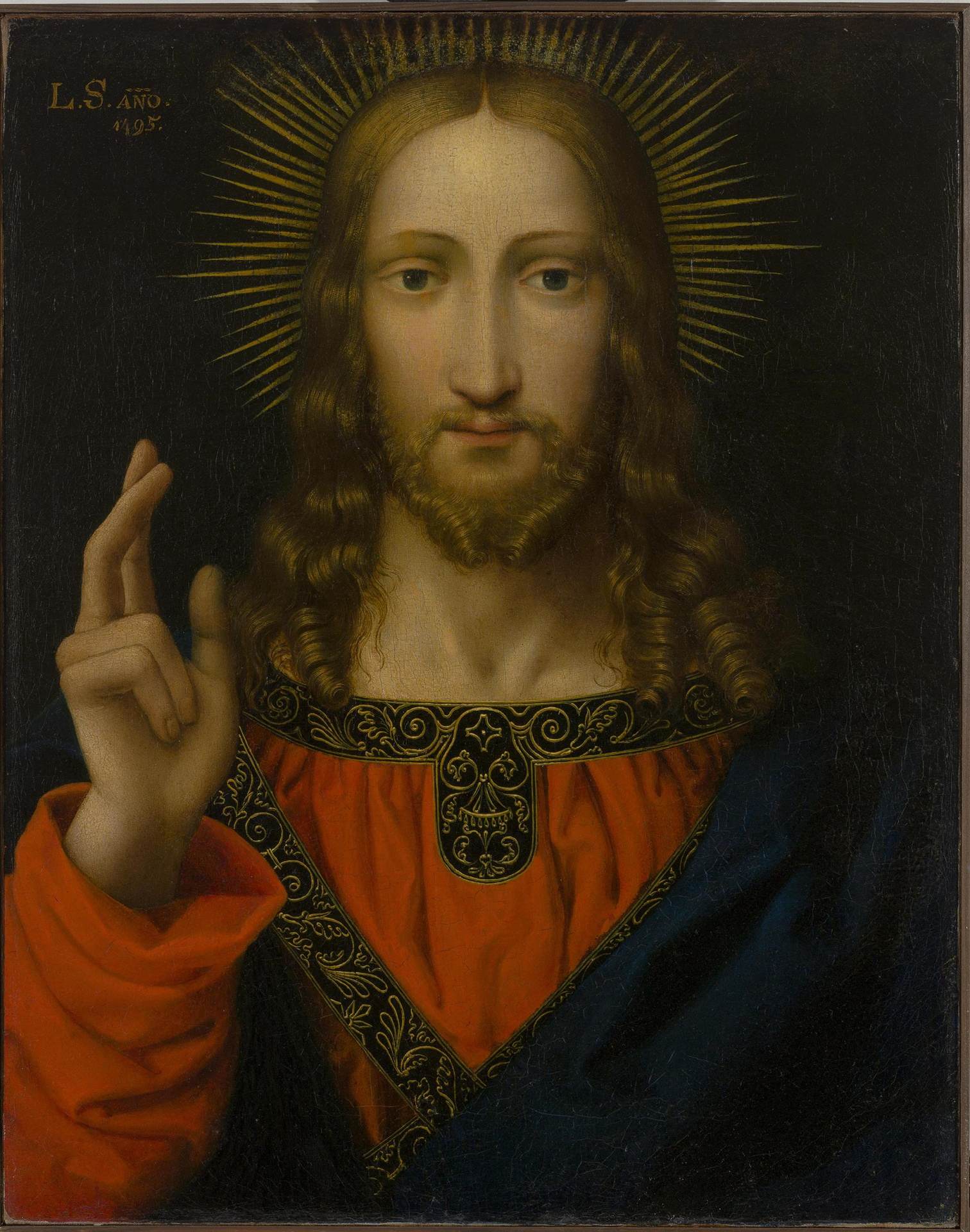

One) A Wider and a Narrow Frame: Marco d’Oggiono and Venice
It is worth noting that we have reason to believe now, with the Hermitage picture, dated 1495, that Leonardo’s Salvator
Mundi design in fact preceded Dürer’s c. 1500 self-portrait, the eternal winner of the ›who blinks first contest‹,
engaging with each and every viewer. And we should add, to discuss Leonardo’s design – probably preserved in the
Hermitage painting – within an adequately wide frame, that Antonello da Messina’s Blessing Christ (in the
National Gallery of London) precedes both.
While having some traits in common, these three pictures named, are, of course, very different. And it is worth asking
what exactly might make them different:
Leonardo da Vinci, while not being a very sociological thinker, is not without sociology at all. His Christ, who is
engaging with each and every viewer directly and rather aggressively (I have spoken of an inquisitory gaze, and pointed
out that this design appears to have been developed within a Dominican context), is an embodiment of the idea that
religious correctness is about each and every individual. It is systematic, in one word. No viewer gets spared – the
picture engages with everyone. Not only in an inquisitory way, because there is also the blessing hand. But firstly one
should not confuse the picture of a blessing gesture with an actual blessing given, and secondly, neither inquisitory
gaze nor blessing hand can be viewed as if existing without its counterpart: blessing might be given (as the customs
officer might allow you to pass with a more or less vigorous gesture waving you through), but before that happens, the
passenger, the sinner, the viewer has to engange with the gaze of Christ (or of the customs officer).
The Blessing Christ by Antonello, not only because of the parapet, might remind a modern viewer (familiar with reality
television shows that deal with customs officers) of a customs officer who is not as rigidly engaging with each and every
passenger as Leonardo’s design does. Actually Antonello’s painting, inspired by a Flemish model, rather seems to
anticipate later Venetian depictions of Christ as the Salvator Mundi, that have Christ care less about the individual
viewer, than rather having him, seemingly absent or gazing into the distance, caring about other things, the bigger
picture for example, new technologies to adapt, by which any kind of religious control might be simplified, but certainly
not (at least not obviously) about the individual viewer, who thus might be spared the inquisitory gaze that Leonardo
obviousely has provided Christ with (in a Dominican context).
Dürer, Christ-like, but usually rather seen as the embodiment of (artistic) self-confidence, is sparing the viewer an
inquisitory gaze as well: his eyes, directed at the viewer, are not seeing right through the viewer, since Dürer has
spared us the (Leonardesque) ambiguity of having to think, if Christ may be (only) looking at us, or if rather he may be
focussing at a point inside us (or in our personal luggage as sinners), hence seeing right through us (or reminding each
and everyone of us that we can be seen right through).
In our last episode we had seen that we can very reasonably speak of a ›Marco group‹ of Salvator Mundi pictures, and that
we should stay aware not be calling Marco d’Oggiono one of Leonardo’s ›boys‹, because otherwise we would not be able to
acknowledge that Marco had his own apprentice (Protasio Crivelli), even before he (Marco) started to work with Leonardo
in the 1490s.
If, as we can suppose, Leonardo created the design of a Christ blessing in around 1495, we have a two years timeframe in
which Marco might possibly have produced some Salvator Mundi pictures (of the ›Marco group‹) with Protasio or with other
painters, since Protasio was autonomous in 1497 and went on to work in Naples.
And Marco, this is now important in our Venetian context, was not only a painter who tended to adapt and to somewhat
simplify Leonardo’s designs, and he was not only the one of the Leonardeschi with a flavour for maps (as an inventory of
his belongings did indicate), in 1498 Marco was also commissioned to do a work for the Scuola dei Milanesi in Venice.
Thus, if he did work in Venice or not to realize that commission, Marco had relations with Milanese in Venice, even
before Leonardo stayed (briefly) in that city.
We have a ›Marco group‹, we see Marco having relations with Milanese (merchants, as I suppose) in Venice, and it seems
not very far fetched to think that, among people who appreciated him as a painter, Marco may also have found people
interested to have him painted pictures of Christ for private religious devotion. And this is what I meant, if above I
said that Leonardo’s design may have reached Venice even before Leonardo reached that city. Marco might have been the
reason. One possible reason. Because there are others and we will come to them.
It may also be possible that the commission given to Marco included marginal decorations, just as the commission for
Santa Maria delle Grazie given to Leonardo was not limited to The Last Supper. And in our context I would like, for
once, point to ceilings, done in Venice by some Leonardesque artists (below a Milanese example, associated with Zenale).
And some examples are named and shown in the 1992 exhibition catalogue Leonardo & Venice (p. 112f.).

Two) Giovanni Agostino da Lodi and Venice
Giovanni Agostino da Lodi who had incorporated Leonardesque ideas to the degree that one may speak of ›essays in
Leonardism‹ (see Peter Humfrey in Leonardo & Venice, p. 359), also was working in Venice before 1500, in which year
he finished and dated a work for the chapel of a scuola (above). Giovanni Agostino, who is not exactly one of the more
prominent Leonardeschi, should definitely be more in the focus of scholars, since he must have been present in Milan in
around 1495 (to adapt Leonardos’s ideas for the Last Supper), and he was in close contact with Boltraffio and Marco
again in 1511, and even cooperated with Marco in 1517, after he had spent several years working in Venice. It is also
obvious, in my view, that he actively cooperated with Giampietrino in around 1511, and considering his trajectory as an
artist Peter Humfrey names also Boltraffio as an influence. One may wonder if Giovanni Agostino can be counted among
›Marco people‹ as well as among ›Boltraffio people‹, and as someone being around Leonardo in 1495, and being in Venice
only shortly afterwards, he may also be someone who might have been capable to transmit the design of a Blessing Christ
to Venice. If this was ever the case, we don’t know, but it is about highlighting the consequences of our finds here, as
well as the possibilities that derive thereof.
Giovanni Agostino also does represent an interest for a hyperrealism more Flemish in nature, and I have repeatedly shown,
in the past, the image of how Giovanni Agostino represented bread seen through wine (below; picture: Sailko).
This is not the kind of realism Leonardo was interested in (although he might have seen examples of Flemish hyperrealism
in Florence), and it may remind us here that Leonardo, despite or because of all his interest in the representation of
the visual nature, he also tends to transform his views of nature into poetic visions, some in the service of a (lucid)
Catholic mysticism, others in the service of secular, but also poetic portraiture.
Three) The Second Best Hand
Leonardo’s stay in Venice, early in 1500, was so brief that, as a Leonardo biographer, one may be tempted to give it
more weight than it, biographically, might have had. For example by speaking about the winter in Venice (I have heard
that it can be freezingly cold, but strictly speaking this is nothing but hearsay), or by picturing the scene of Leonardo
contemplating the Colleoni monument (see picture on top), a work by his teacher Verrocchio, right next to the (Dominican)
church of San Zanipolo. Or by being even more inventive: as a screenwriter, for example, I would create a scene of Salaì
throwing a snowball at an Isabella d’Este snowwoman (workshop & Leonardo), while Leonardo, with his entourage, is
wondering what might have happened to the clay horse model left back at Milan.
Charles Nicholl, intelligently and elegantly, takes the opportunity for embarking on a short excursus as to the subject
of ›Leonardo and the printing press‹, reminding us that Leonardo speaks of the printing press as ›having many children‹,
while painting remains something unique. And I am tempted here to insert a brief scene of Salaì proposing to Leonardo to
learn from the example of Giovanni Bellini, because, as far as we know, and as far as we are discussing a ›Renaissance of
the Cartoon‹, post-1500 Leonardo cannot be referred to as the example of a painter very strictly implementing a
one-child-policy as to his pictures. In fact: Leonardo must have known that even the fragile (as well as rock solid)
Cenacolo was copied by his followers, as he must have been willing (after 1500 especially) to turn more and more to
serial production (as perhaps Marco had been even before 1500), and his views on painting, transmitted by later
compilations might be referred to as being early Sforza court rhetoric. Leonardo, after his brief stay at Venice, turned
back to Florence, where, as also Nicholl is mentioning, Lorenzo di Credi had taked over Verrocchio’s workshop, and it
might even be that the two pictures of a woman (Columbia and Russian private collection; see right column) are among the
first examples of Leonardo embarking on a Renaissance of the Cartoon and on serial productions (and it may even have been
indeed Lorenzo di Credi who might have helped him with finishing the Columbia picture). But back to Venice.
It is striking that, in the case of Giovanni Bellini, we actually have all the ingredients of a Salvator Mundi saga: we
have numerous sources speaking of pictures by Bellini (or by Bellini or one of the Belliniani), pictures of Christ
blessing (the price for one such picture was 50 ducats; see storiedellarte), we have the attempts to identify certain
pictures as certain pictures mentioned in the sources, he have scholarly activities that go along with activities on the
art market, we have specialist digging and bloggers blogging, but still we don’t see, perhaps we may say: thank God!, we
don’t see a similar frenzy in the field of Bellini (studies) as we see in the world of Leonardo (where the world of
specialist is not free of such frenzy at all).
Not that we would miss such ›hunting scenes in the lagoon‹, no; what one may hope for is rather, on the one hand, that
Leonardo studies would take some inspirations from activities in the Bellini field (a dissertation dedicated to the
history of the Bellini workshop does exist), and on the other hand, that one would attempt to compare more. Because the
connoisseurship of Leonardo may not be the same thing as the connoisseurship of Bellini, but it still is:
connoisseurship, with all the shades, and with all the kinds of resonance being associated with this very term.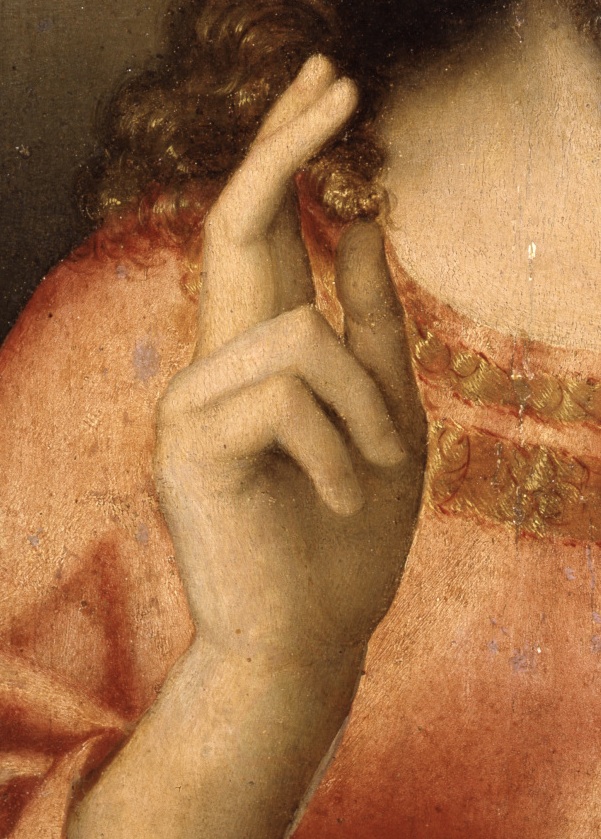

And there is something else, and this something else is one further consequence of the Hermitage find: one actually
cannot divide the field, since in Bellini’s Venice Leonardo’s design might have been present very early.
If we look for example at this Christ Blessing (above), now attributed to Rocco Marconi (pictures: lacarrara.it) – I must admit
that I find it difficult to decide if here we see Leonardesque influences or not. The picture is in the Accademia
Carrara, Bergamo, and had earlier been identified as a work by Bonifazio de’ Pitati. The blessing hand, rather close to,
but not exactly identical with the Leonardesque design, has always struck me as one of the best hands in the field of
Salvator Mundi studies, and still I do not dare to decide, if, here, we see the Leonardesque influence. We have seen that
it would be possible: Giovanni Agostino da Lodi or Marco d’Oggiono might have brought pictures or ideas to Venice;
Venitian artists might have the chance to adapt them or at least to compare. Because one may also think that Venititian
artists experimented with the frontal pose and with the direct gaze as well. Be it as it may: the idea of the frontal
pose, combined with a blessing hand, strikingly reminding of Leonardo, and reminding of the earliest option 1 (as to the
thumb), we encounter in Venition paintings from the school of Bellini (below an art market variant; picture:
christies.com; the attribution is ›Circle of Bellini‹).
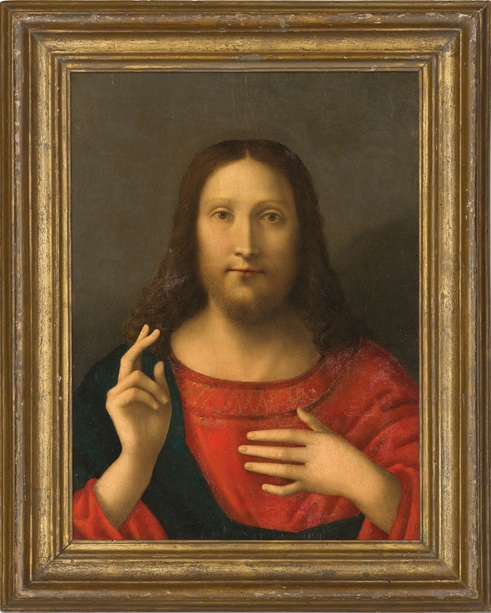
Four) Beyond an Inquisitory Stare
It is also striking that, in the field of Bellini and workshop, we on the one hand find the very direct gaze, reminding
of Leonardo’s design, and on the other hand we find alternatives to that very direct inquisitory stare, and it is almost
as if these alternatives are meant to avoid such direct inquisitory stare very deliberately. We had seen that
Antonello da Messina’s Christ Blessing seems to anticipate, what Giovanni Bellini, was to elaborate more
decidedly: a staging of Christ close to a viewer, who, still, is spared the direct gaze, and placed next to a Christ who
seems (more or less) absent, introspective or gazing (vaguely) into the distance (the picture below shows a painting that
can be identified with a Bellini original as it is mentioned in the sources; picture: fondazionezeri.unibo.it; and see
again: storiedellarte).
With Titian we are reminded again that the essence of a Salvator Mundi is also a specific political theology, while the
essence of a Christ blessing is not necessarily such. A globe or an orb makes a difference, and a gaze directed into a
remote distance as, respectively, the introspective gaze directed at the whole (cosmos), is, very directly, implying
space: the global space as the generation of Titian could see it, and the space Marco d’Oggiono, the collector of
maps, must have been fascinated with from early on. It is also the space a viewer is now implied in or positioned in, and
this space is of another kind than the narrow space that is defined by the positioning of the viewer in direct
confrontation with the inquisitory stare of the Leonardesque design. The picture Ottawa (Bellini workshop; dated c. 1500)
might be seen as one in such influences cross (large picture below: gallery.ca).

Selected literature:
Leonardo & Venice, ed. Paolo Parlavecchia, Milan 1992
Per la provenienza di un ›Cristo benedicente‹ di Giovanni Bellini dal complesso agostiniano di Santo Stefano a Venezia, storiedellarte

The Bottega of Leonardo da Vinci
The picture of the bottega of Leonardo da Vinci is not as blurred as one might imagine (for details see Seidlitz 1935, p. 530; Marani 1998). We will focus here on the early and middle years (up to 1512), and not on the late years, and one might begin with saying that with Boltraffio and Marco d’Oggiono we see two figures enter the orbit of Leonardo at the beginning of the 1490s that we believe to know rather well. We also see Salaì enter the orbit, at a very young age, and we have, in addition to that, a couple of names, names of figures that we do not seem to know very well, or not at all (a Giacomo, Giulio Tedesco, Galeazzo). Last but not least we have the Giampietrino problem: Giampietrino enters the scenery, but it is a matter of controversy (as far as this question is debated at all), when, since also Giampietrino is still very young.
It is noteworthy that Marco d’Oggiono, already at the end of the 1480s, seems to have had an own apprentice, and that Marco and Boltraffio did create the Pala Grifi together (a picture today in Berlin; picture above), even before Leonardo began to work at The Last Supper in 1495. Due to the work of Janice Shell and Grazioso Sironi we today do know more about Francesco Galli, also called Francesco Napoletano, who did die in Venice as early as 1501. One might imagine that Galli went to Venice with Leonardo in 1501, and if Galli, during the 1490s, for example might have cooperated with Marco, we would have found an interesting perspective: since, if only one single picture of the Marco group would be associated with Francesco Galli/Francesco Napoletano, we would have a picture with hand option 2, a picture that must have been created before Galli died in 1501. Which would mean that hand option 2 must have existed early, and my theory of the pentimento in version Cook as a mere switching from (preexisting) option 1 to (preexisting) option 2 would be positively proven as well as the theory of the pentimento supposedly showing the creative energy of genius (changing his mind) would be definitively falsified.
Brief: in the 1490s Leonardo mentions once that he had paid ›two masters‹ (probably Marco and Boltraffio) for two years; and once that he had six bocche to feed (probably again Marco, Boltraffio, plus Salaì and some of the unknowns).
Below a rather early Marco picture (according to Janice Shell), the Young Christ Blessing of the Galleria Borghese:
And here is a picture (not the only known picture) by Protasio Crivelli, formerly the apprentice of Marco d’Oggiono (picture by Sailko; the date appears to be 1498; location: Naples, Museo di Capodimonte):
In 1501 (3.4.) Pietro da Novellara informs Isabella d’Este that Leonardo seems to live ›from day to day‹ (see Marani 1998, p. 14). And he has seen Leonardo intervening from time to time in portraits done by two of his garzoni (»fano retrati«). But who are these, and which portraits are these (if this would have been about a Isabella d’Este portrait, Pietro would have noted; and after the Sforza had been expelled, portraits of court ladies and courtiers made no sense)? After having written on the picture of a young woman in the Columbia Museum of Art in one of the last episodes, I would now suggest the following:
Leonardo might have done a portrait of a Sforza court lady in the early Milanese years (and still in the Florentine portrait style), a portrait in terms of a drawing or a cartoon. He might have begun also a painting, but since the Sforza court got expelled and exiled after the French invasion, he might not have finished such portrait. He might instead have used it for the instruction of his garzoni: the Columbia picture might have been the one begun by Leonardo (as he seems to have begun portraits with the face, as later in the Mona Lisa), a picture that he might have had a pupil finish, with him retouching it again, adding some lustre. The picture in a private Russian collection might be a second version that he had a pupil repeat (after the first version and the drawing, respectively the cartoon). The Columbia picture shows much gusto for the grotesque, the second version less so, but still to some degree. Thus we would see pictures that have their origins in the first Milanese period (and even in the early Florentine period), but were actually done later (after 1500). And Leonardo might have had a hand in the Columbia picture whose head with the hair as well as the ornated hair net superbly being modelled into the dark is of exquisite quality (as also a single one pearl is, while other pearls are rather mediocre as also the bust and the modelling of the dress is). We see, as I have attempted to show in episode 13, two pictures that fit into the context of Leonardo’s thinking and doing rather than into the context of Boltraffio’s autonomous work: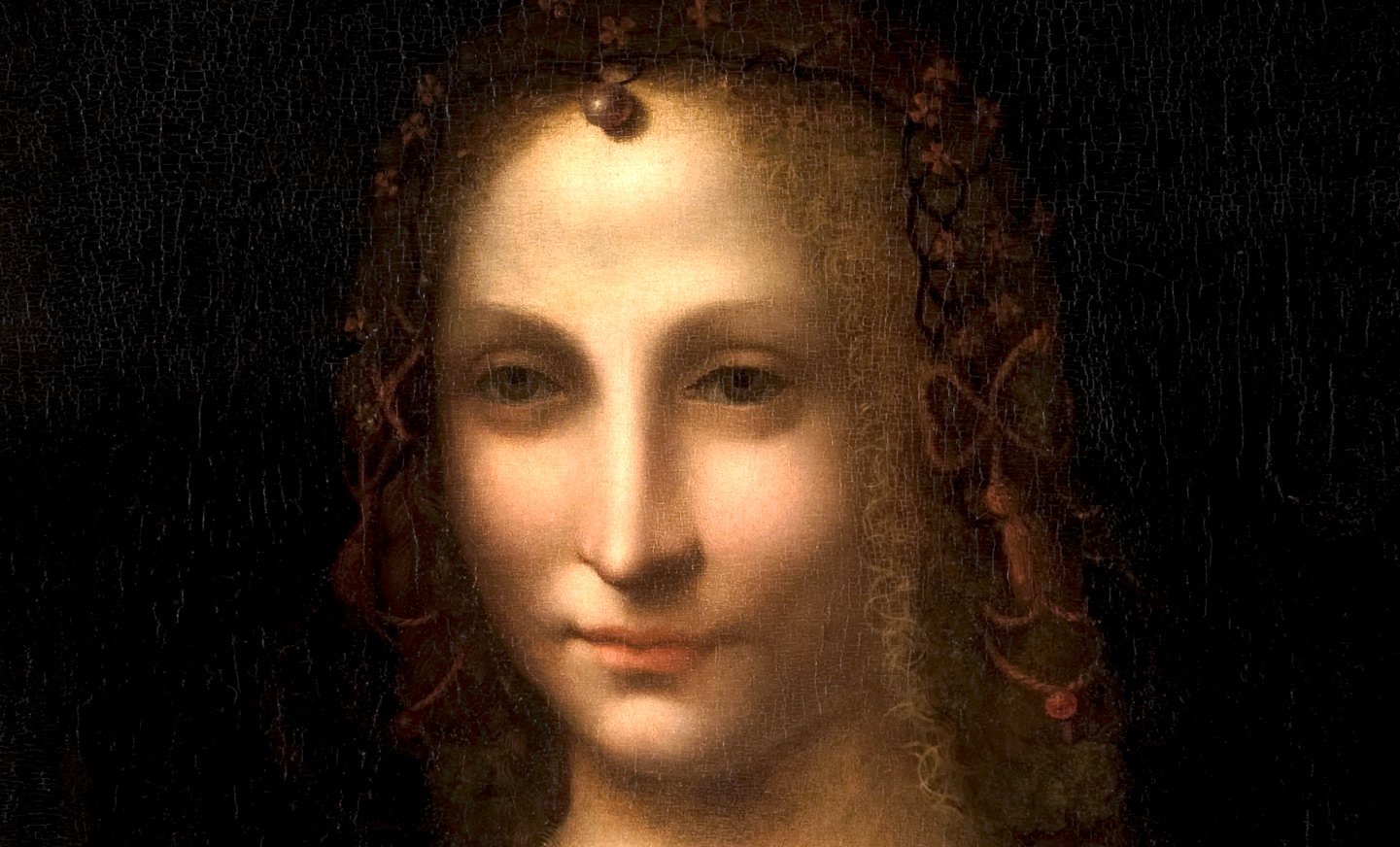
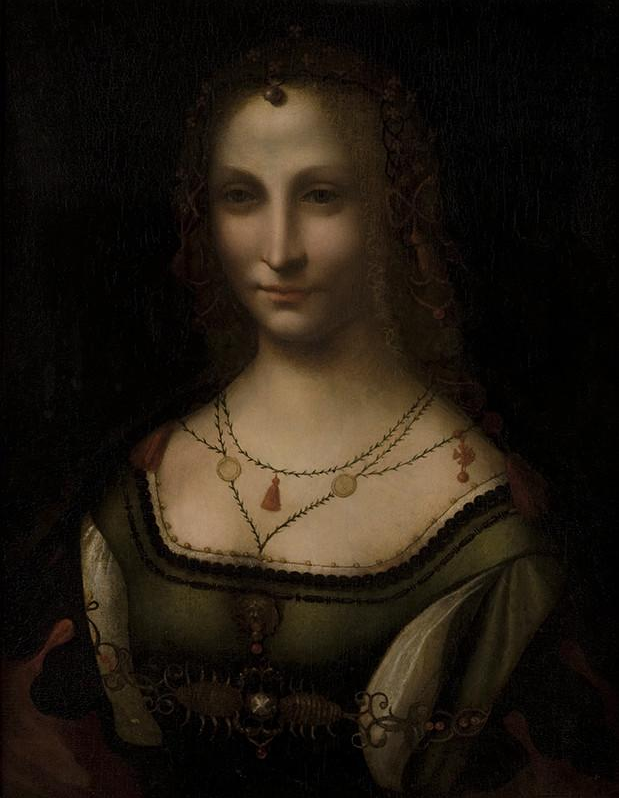
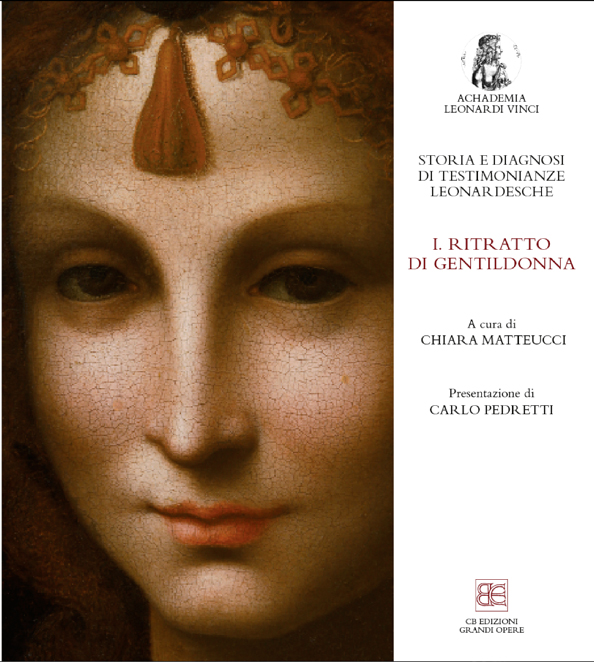
In 1504 a Jacopo Tedesco, in 1505 a Lorenzo (di Marcho) enter the orbit of Leonardo.
In around 1505 Fernando Yáñez enters the orbit of Leonardo, helping him with the Battle of Anghiari (as also does Riccio della Porta). Yáñez cannot be the author of the Prado Mona Lisa, if the Louvre Mona Lisa was finished only years later, since the dates (showing that Yáñez was active in Spain after 1506) do not allow to postulate it. In works of Yáñez done in Spain, however, we find echoes of Leonardo’s works (see the example below).
Around 1507 Francesco Melzi becomes a pupil of Leonardo (and also a sort of secretary).
In 1511 (or even earlier) Giampietrino is an autonomous master.
In 1511 Salaì seems to have created a (signed and dated) picture of Christ:
In around 1511 we see Marco, Boltraffio, Giampietrino and – Giovanni Agostino da Lodi in close contact, not only because we have a source indicating exactly that – we also have pictures indicating exactly that, and one of these pictures seems to be even dated (but the ›date‹ – ›XII‹ – is rather referring to the ›age of Christ‹):
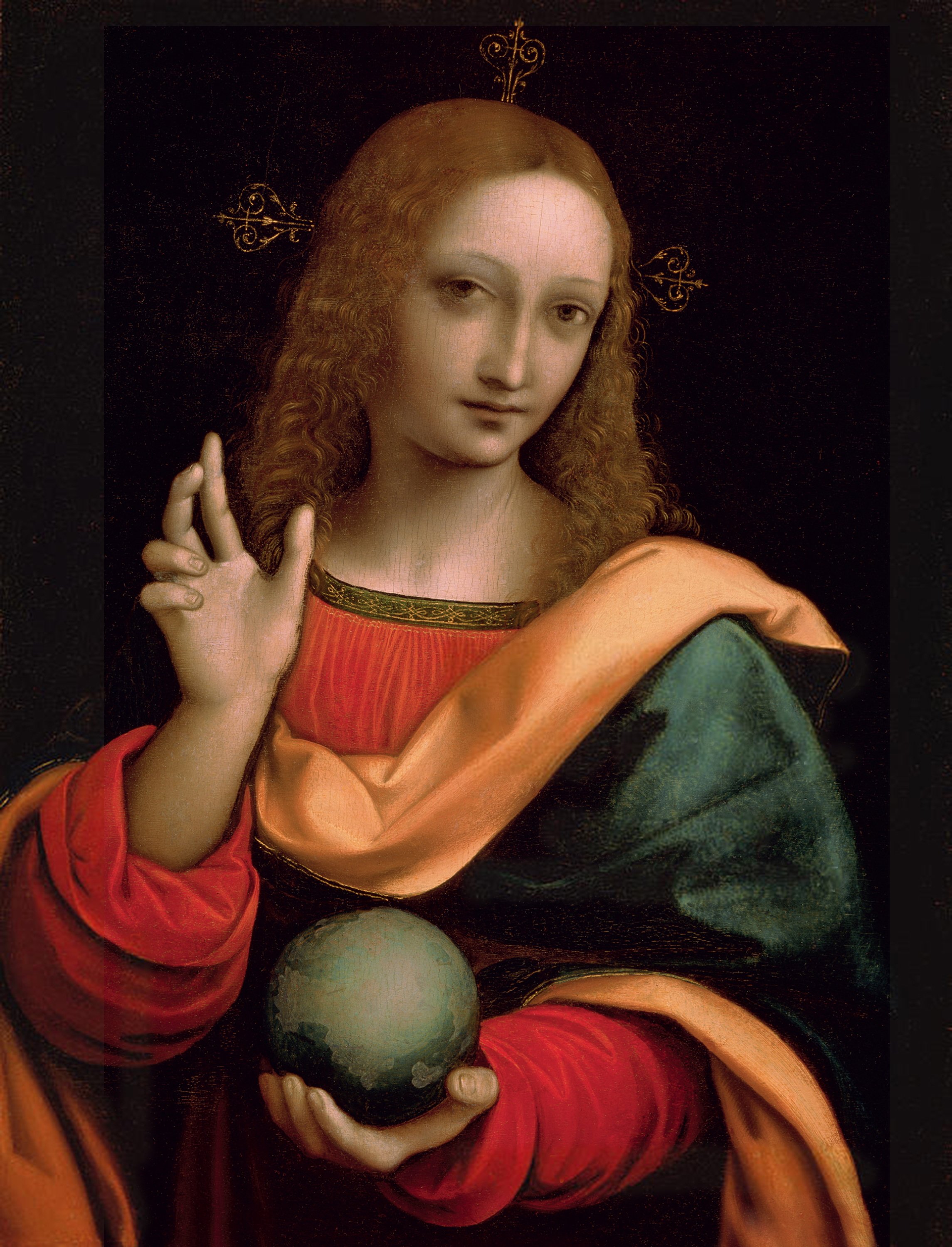
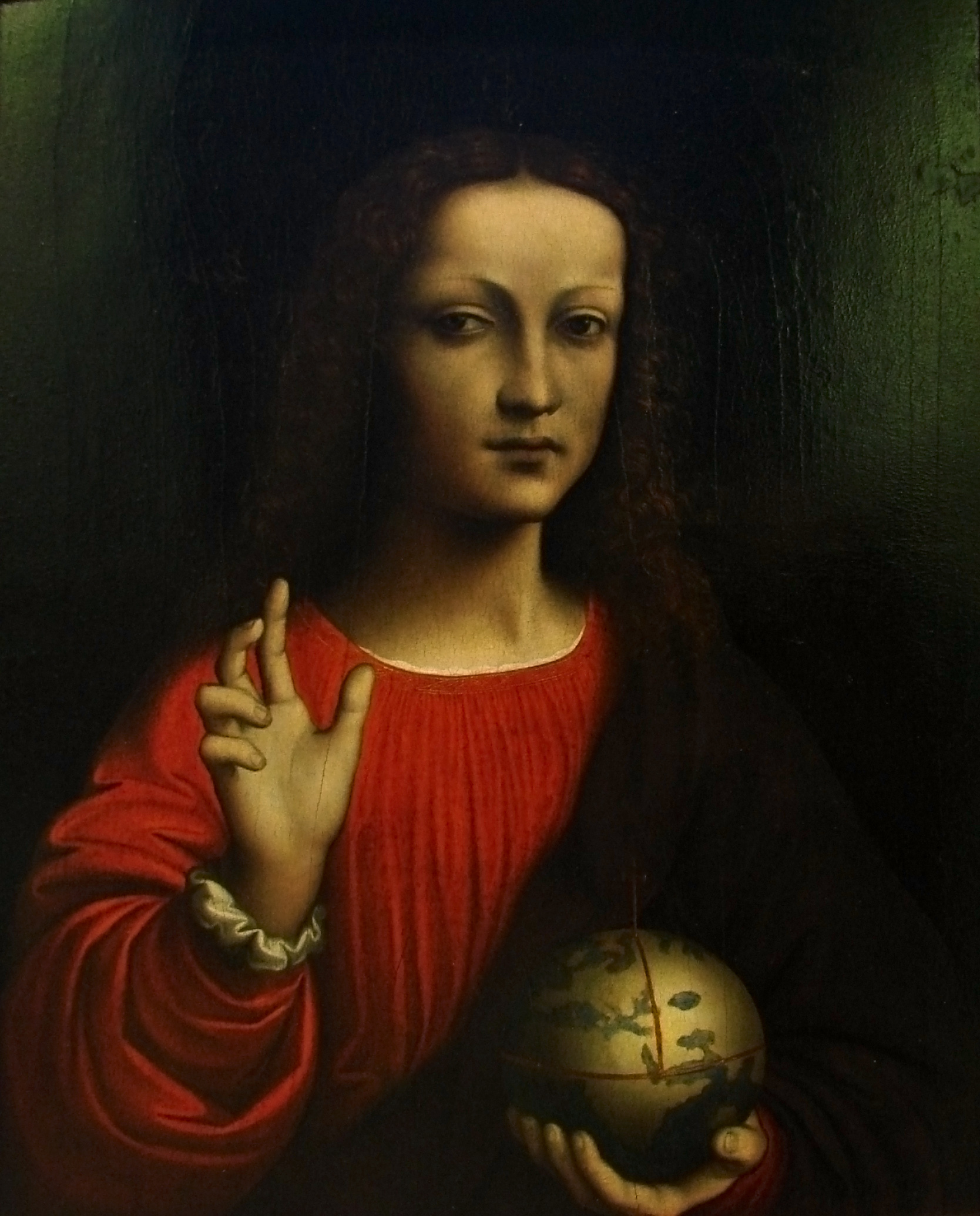
The Prado Mona Lisa (below) was probably begun at the time Leonardo also started reworking or completing the Louvre Mona Lisa, probably due to Giuliano de’ Medici wishing so, and hence perhaps in around 1511/12.
In around 1517 Marco d’Oggiono is cooperating with Giovanni Agostino da Lodi (see Shell, p. 173).
***
1516: Paolo Emilio, Italian-born humanist at the court of Francis I, publishes the first four books of his history of the Franks; death of Boltraffio.
1517: Leonardo da Vinci, with Boltraffio and Salaì, has come to France (picture of Clos Lucé: Manfred Heyde); 10.10.2017: Antonio de Beatis at Clos Lucé
1517ff: Age of the Reformation; apocalyptic moods; Marguerite of Navarre, sister of Francis I, will be sympathizing with the reform movement; her daughter Jeanne d’Albret, mother of future king Henry IV, is going to become a Calvinist leader.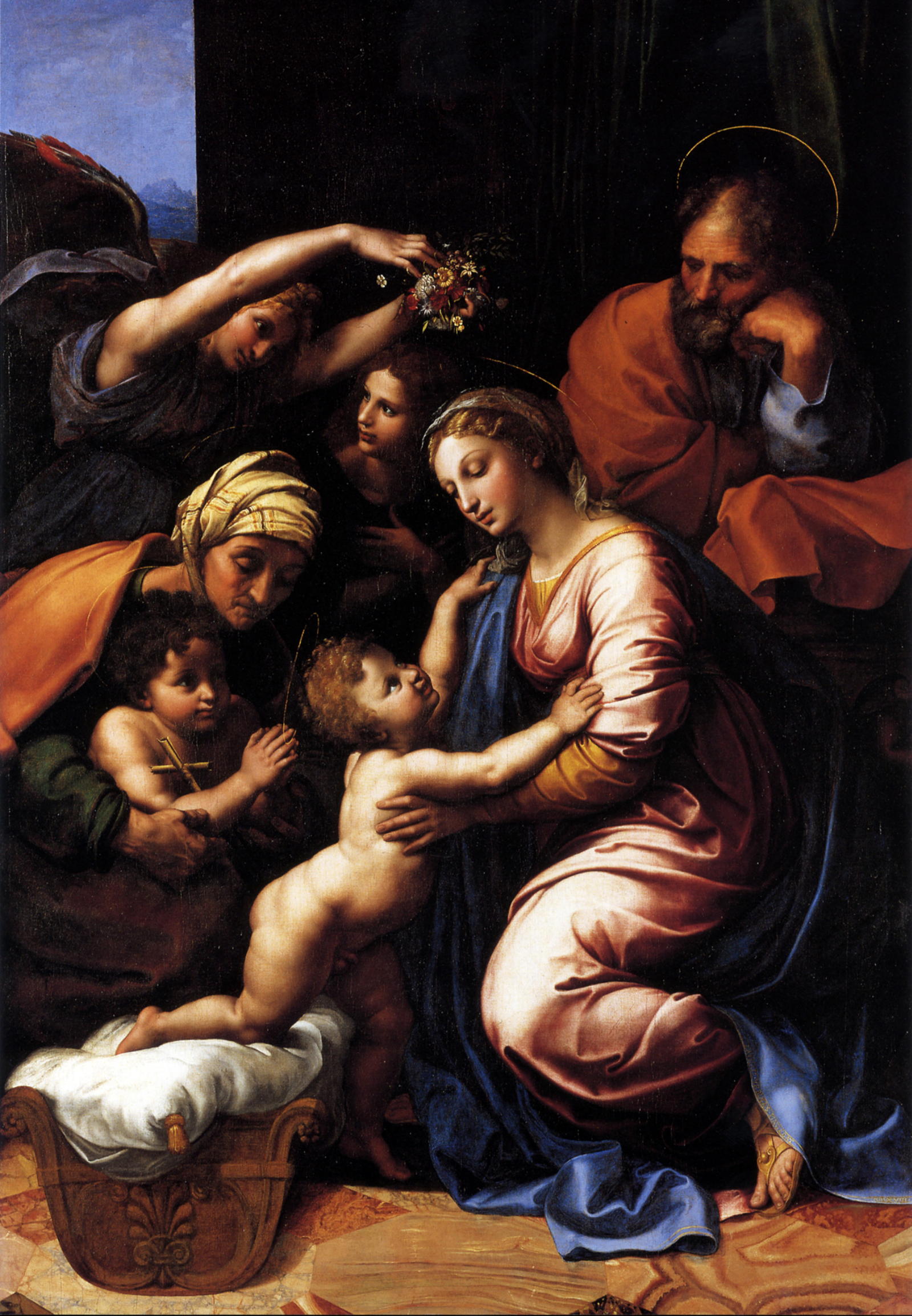
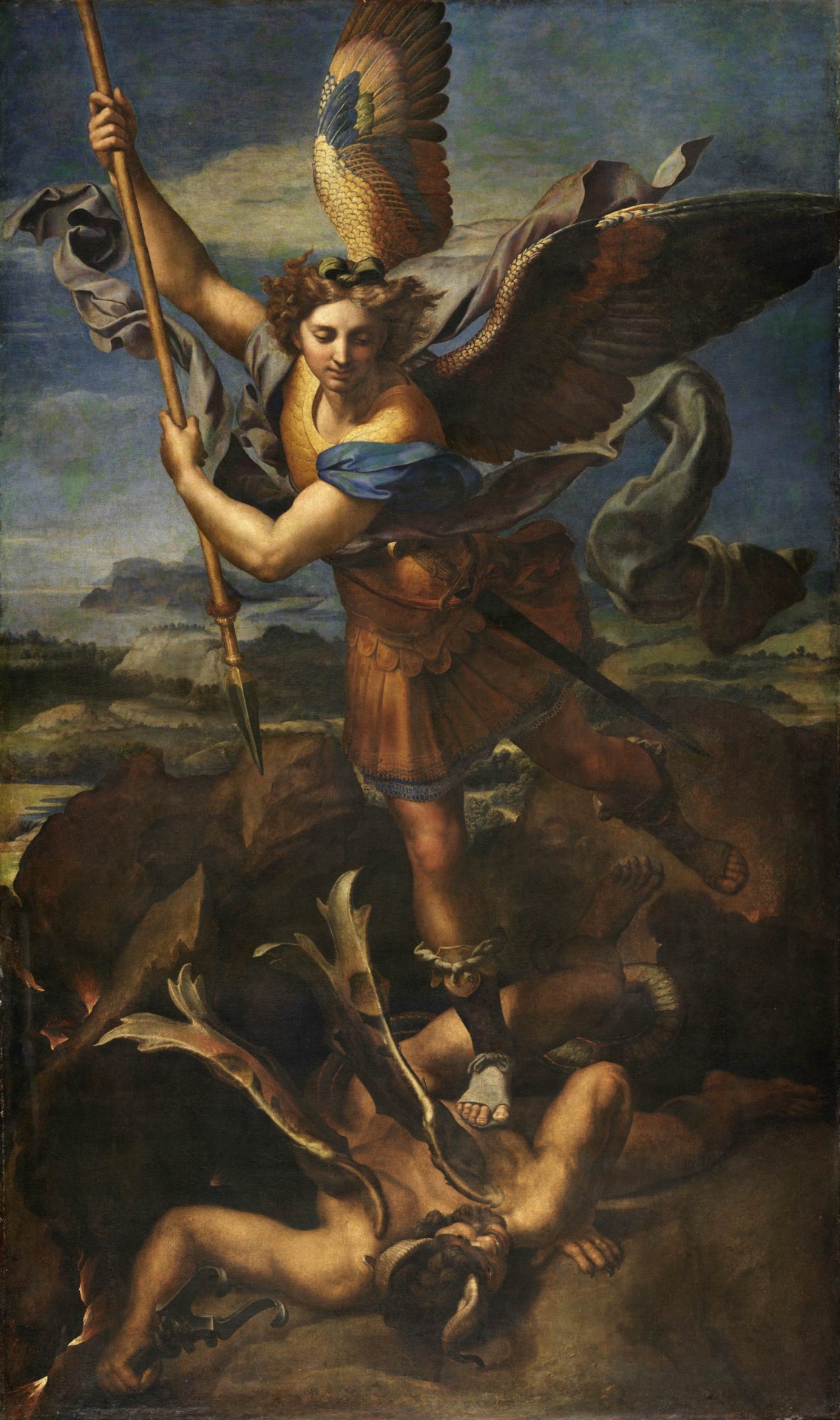
1518: the Raphael workshop produces/chooses paintings to be sent to France; 28.2.: the Dauphin is born; 13.6.: a Milanese document refers to Salaì and the French king Francis I, having been in touch as to a transaction involving very expensive paintings: one does assume that prior to this date Francis I had acquired originals by Leonardo da Vinci; 19.6.: to thank his royal hosts Leonardo organizes a festivity at Clos Lucé.
1519: death of emperor Maximilian I; Paolo Emilio publishes two further books of his history of the Franks; death of Leonardo da Vinci; Francis I is striving for the imperial crown, but in vain; Louise of Savoy comments upon the election of Charles, duke of Burgundy, who thus is becoming emperor Charles V (painting by Rubens).
1521: Francis I, who will be at war with Hapsburg 1526-29, 1536-38 and 1542-44, is virtually bancrupt.
1523: death of Cesare da Sesto.
1524: 19.1.: death of Salaì after a brawl with French soldiers at Milan.
1525: 23./24.2.: desaster of Francis I at Pavia. 21.4.1525: date of a post-mortem inventory of Salaì’s belongings.
1528: Marguerite of Navarre gives birth to Jeanne d’Albret (1528-1572) who, in 1553, will give birth to Henry, future French king Henry IV.
1530: Francis I marries a sister of emperor Charles V.
1531: death of Louise of Savoy; the plague at Fontainebleau.
1534: Affair of the Placards.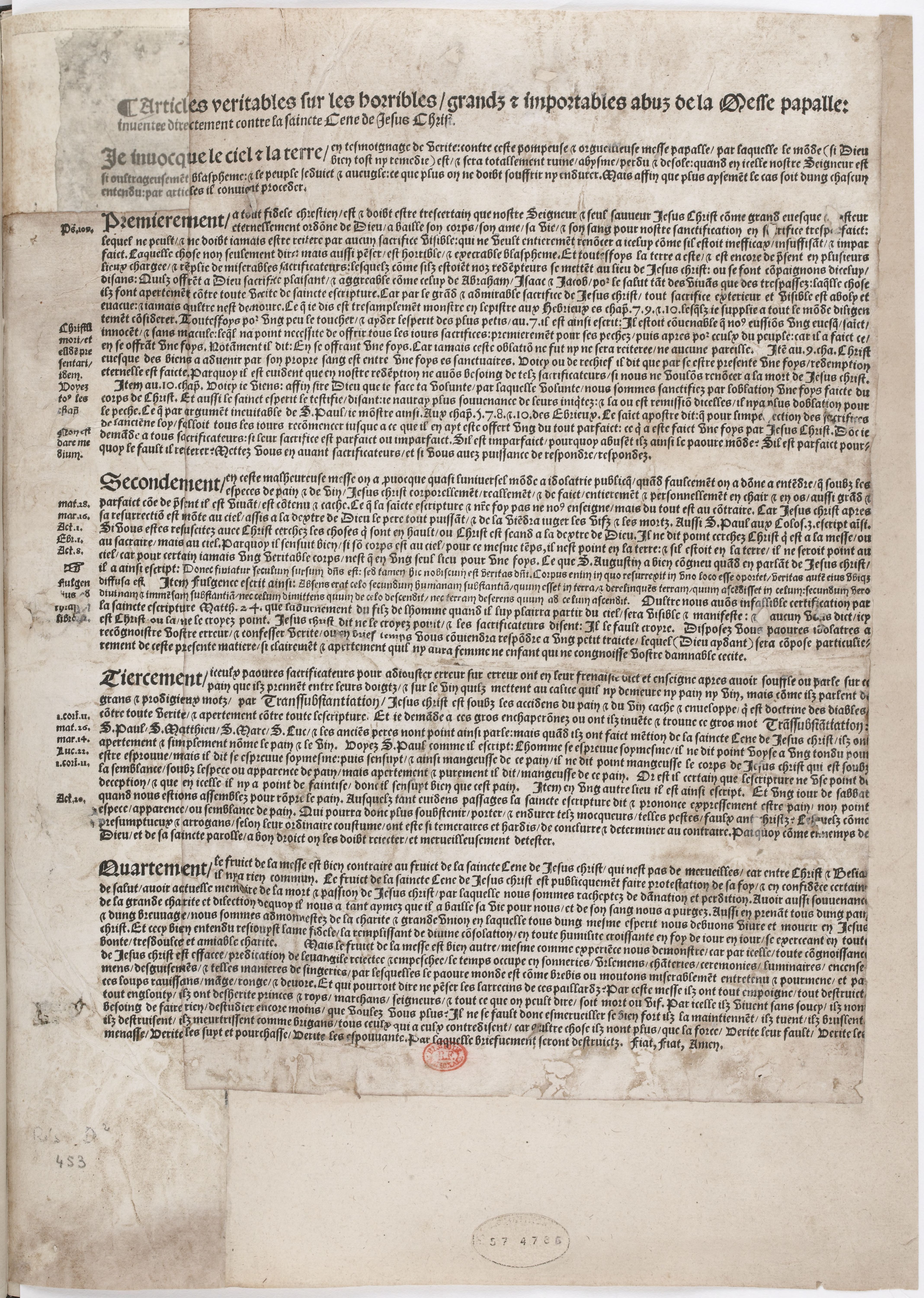
1539: the still unfinished chateau of Chambord is being shown by Francis I to Charles V.
1540s: the picture collection of Francis I being arranged at Fontainebleau.
1544: January: Marguerite of Navarre sends a letter of appreciation to her brother, king Francis I., who has sent her a crucifix, accompanied by a ballade, as a new year’s gift.
1547: death of Francis I.
1549: death of Marguerite de Navarre; death of Giampietrino.
1553: Jeanne d’Albret gives birth to Henry, the future French king Henry IV and first Bourbon king after the rule of the House of Valois.
1559: publication of the Heptaméron by Marguerite de Navarre.
1562-1598: French Wars of Religion.
1570: death of Francesco Melzi.
1589: Henry, grandson of Marguerite de Navarre and grand-grandson of Louise of Savoy, but by paternal descent a Bourbon, is becoming French king as Henry IV.
2015: an exhibition at the Château of Loches is dedicated to the 1539 meeting of king and emperor (see here).

Giampietrino’s Kneeling Leda is just another example of a painting having been created on the basis of a cartoon (see Leonardo biography by Charles Nicholl, German edition, p. 541)
See also the episodes 1 to 15 of our New Salvator Mundi History:
Francis I and the Crown of Charlemagne
The Chronicles of Santa Maria delle Grazie
And:
MICROSTORY OF ART
ONLINE JOURNAL FOR ART, CONNOISSEURSHIP AND CULTURAL JOURNALISM
HOME
© DS